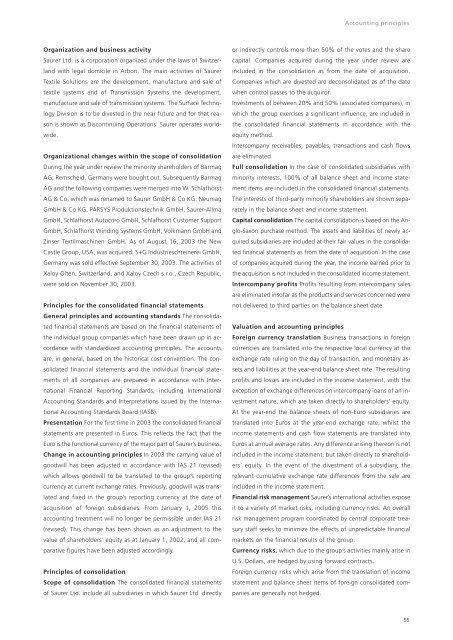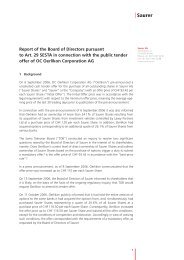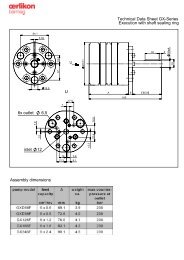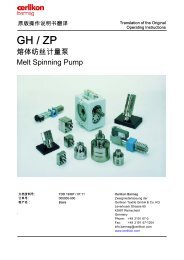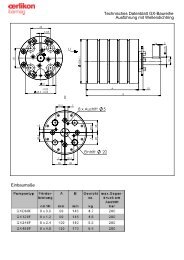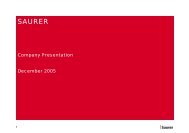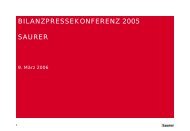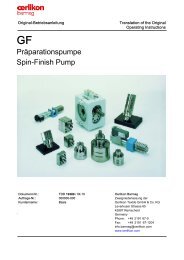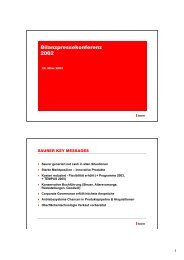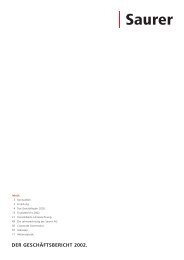We make our customers successful. - Oerlikon Barmag
We make our customers successful. - Oerlikon Barmag
We make our customers successful. - Oerlikon Barmag
Create successful ePaper yourself
Turn your PDF publications into a flip-book with our unique Google optimized e-Paper software.
Organization and business activity<br />
Saurer Ltd. is a corporation organized under the laws of Switzerland<br />
with legal domicile in Arbon. The main activities of Saurer<br />
Textile Solutions are the development, manufacture and sale of<br />
textile systems and of Transmission Systems the development,<br />
manufacture and sale of transmission systems. The Surface Technology<br />
Division is to be divested in the near future and for that reason<br />
is shown as Discontinuing Operations. Saurer operates worldwide.<br />
Organizational changes within the scope of consolidation<br />
During the year under review the minority shareholders of <strong>Barmag</strong><br />
AG, Remscheid, Germany were bought out. Subsequently <strong>Barmag</strong><br />
AG and the following companies were merged into W. Schlafhorst<br />
AG & Co, which was renamed to Saurer GmbH & Co KG: Neumag<br />
GmbH & Co KG, PARSYS Produktionstechnik GmbH, Saurer-Allma<br />
GmbH, Schlafhorst Autocoro GmbH, Schlafhorst Customer Support<br />
GmbH, Schlafhorst Winding Systems GmbH, Volkmann GmbH and<br />
Zinser Textilmaschinen GmbH. As of August 16, 2003 the New<br />
Castle Group, USA, was acquired. S+G Industrieschreinerei GmbH,<br />
Germany was sold effective September 30, 2003. The activities of<br />
Xaloy Olten, Switzerland, and Xaloy Czech s.r.o., Czech Republic,<br />
were sold on November 30, 2003.<br />
Principles for the consolidated financial statements<br />
General principles and accounting standards The consolidated<br />
financial statements are based on the financial statements of<br />
the individual group companies which have been drawn up in accordance<br />
with standardized accounting principles. The accounts<br />
are, in general, based on the historical cost convention. The consolidated<br />
financial statements and the individual financial statements<br />
of all companies are prepared in accordance with International<br />
Financial Reporting Standards, including International<br />
Accounting Standards and Interpretations issued by the International<br />
Accounting Standards Board (IASB).<br />
Presentation For the first time in 2003 the consolidated financial<br />
statements are presented in Euros. This reflects the fact that the<br />
Euro is the functional currency of the major part of Saurer’s business.<br />
Change in accounting principles In 2003 the carrying value of<br />
goodwill has been adjusted in accordance with IAS 21 (revised)<br />
which allows goodwill to be translated to the group’s reporting<br />
currency at current exchange rates. Previously, goodwill was translated<br />
and fixed in the group’s reporting currency at the date of<br />
acquisition of foreign subsidiaries. From January 1, 2005 this<br />
accounting treatment will no longer be permissible under IAS 21<br />
(revised). This change has been shown as an adjustment to the<br />
value of shareholders’ equity as at January 1, 2002, and all comparative<br />
figures have been adjusted accordingly.<br />
Principles of consolidation<br />
Scope of consolidation The consolidated financial statements<br />
of Saurer Ltd. include all subsidiaries in which Saurer Ltd. directly<br />
Accounting principles<br />
or indirectly controls more than 50% of the votes and the share<br />
capital. Companies acquired during the year under review are<br />
included in the consolidation as from the date of acquisition.<br />
Companies which are divested are deconsolidated as of the date<br />
when control passes to the acquiror.<br />
Investments of between 20% and 50% (associated companies), in<br />
which the group exercises a significant influence, are included in<br />
the consolidated financial statements in accordance with the<br />
equity method.<br />
Intercompany receivables, payables, transactions and cash flows<br />
are eliminated.<br />
Full consolidation In the case of consolidated subsidiaries with<br />
minority interests, 100% of all balance sheet and income statement<br />
items are included in the consolidated financial statements.<br />
The interests of third-party minority shareholders are shown separately<br />
in the balance sheet and income statement.<br />
Capital consolidation The capital consolidation is based on the Anglo-Saxon<br />
purchase method. The assets and liabilities of newly acquired<br />
subsidiaries are included at their fair values in the consolidated<br />
financial statements as from the date of acquisition. In the case<br />
of companies acquired during the year, the income earned prior to<br />
the acquisition is not included in the consolidated income statement.<br />
Intercompany profits Profits resulting from intercompany sales<br />
are eliminated insofar as the products and services concerned were<br />
not delivered to third parties on the balance sheet date.<br />
Valuation and accounting principles<br />
Foreign currency translation Business transactions in foreign<br />
currencies are translated into the respective local currency at the<br />
exchange rate ruling on the day of transaction, and monetary assets<br />
and liabilities at the year-end balance sheet rate. The resulting<br />
profits and losses are included in the income statement, with the<br />
exception of exchange differences on intercompany loans of an investment<br />
nature, which are taken directly to shareholders’ equity.<br />
At the year-end the balance sheets of non-Euro subsidiaries are<br />
translated into Euros at the year-end exchange rate, whilst the<br />
income statements and cash flow statements are translated into<br />
Euros at annual average rates. Any difference arising thereon is not<br />
included in the income statement, but taken directly to shareholders’<br />
equity. In the event of the divestment of a subsidiary, the<br />
relevant cumulative exchange rate differences from the sale are<br />
included in the income statement.<br />
Financial risk management Saurer’s international activities expose<br />
it to a variety of market risks, including currency risks. An overall<br />
risk management program coordinated by central corporate treasury<br />
staff seeks to minimize the effects of unpredictable financial<br />
markets on the financial results of the group.<br />
Currency risks, which due to the group’s activities mainly arise in<br />
U.S. Dollars, are hedged by using forward contracts.<br />
Foreign currency risks which arise from the translation of income<br />
statement and balance sheet items of foreign consolidated companies<br />
are generally not hedged.<br />
55


